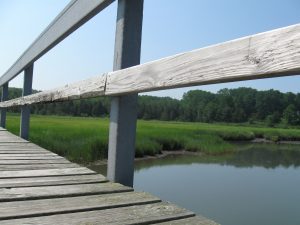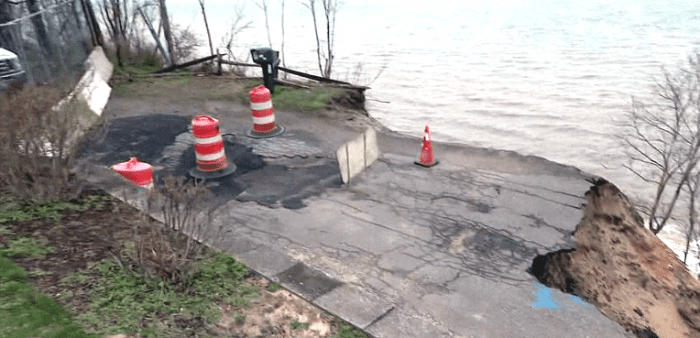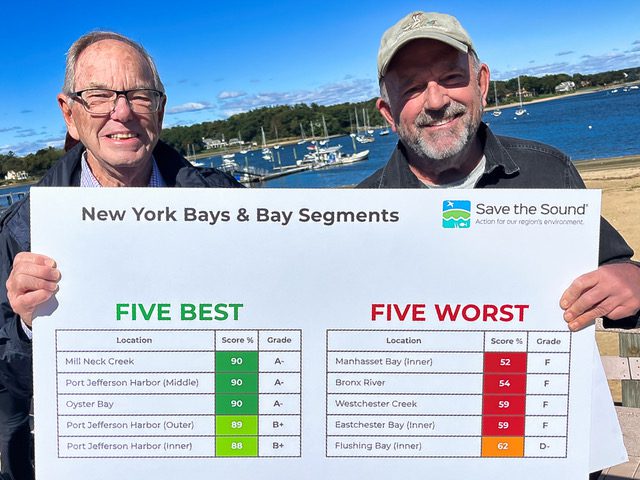A MILLION DOLLAR VIEW
John Dielman of East Setauket snapped this photo ‘looking into the after glow’ at West Meadow Beach on Oct. 17.
Send your Photo of the Week to [email protected]
A MILLION DOLLAR VIEW
John Dielman of East Setauket snapped this photo ‘looking into the after glow’ at West Meadow Beach on Oct. 17.
Send your Photo of the Week to [email protected]

By Lynn Hallarman
Whenever Steve Englebright, 5th District county legislator (D-Setauket) and geologist, is asked about the East Beach bluff stabilization project, chances are he will start by explaining the big picture of bluff erosion on the North Shore of Long Island.
“We [Port Jefferson] are at the doorstep of the greatest amount of erosion of the entirety of the North Shore,” he said to a rapt audience of about 40 people at the Port Jefferson Civic Association meeting Oct. 14.
Englebright spent 40 minutes in an educational deep dive about the shoreline’s composition and history, focusing on how erosion along the 50 miles of the North Shore impacts the village-owned sliver of bluff at the East Beach.
The meeting represents another moment in the ongoing debate among residents and village officials about the project strategies and costs. Mayor Lauren Sheprow, trustee Xena Ugrinsky and several members of the Port Jefferson Citizens Commission on Erosion were present.
Using a whiteboard and marker, Englebright diagrammed how thousands of years of erosion have shaped and reshaped the shoreline. The audience gasped as he recounted the 1904 Broken Ground Slide, in which almost a mile of land just east of Northport let loose and fell into the Long Island Sound in one day.
“The reason I want you to get the big picture is that this is a very unstable shoreline. The basic premise of stabilizing it for a given property [the country club] is mission impossible. Because any given little property is part of a larger dynamic,” he said.
Englebright explained that erosion of the North Shore is accelerating because of our overheating oceans, producing more powerful and frequent tropical storms, further destabilizing the area. “[Bluffs] are not cemented together, so it doesn’t take much to disturb them — like a hurricane. They come apart easily,” he said.
“The county club was unwisely [decades ago] placed too close to the bluff edge,” he said. In the long term, more than just tennis courts will be in harm’s way.”
“What does this all mean?”
“We have to ask some serious questions when we get involved in spending millions of dollars,” he said.
Weighing the pros and cons
Englebright shifted the conversation from a big picture discussion about coastal erosion to a conversation about the project’s immediate and long-term goals.
“I think we’ve already spent something like $5 million in a community of 8,500 people. Do the math: It’s already a significant investment, much of which has already been at least partially compromised in just a couple of seasons,” he said.
He added: “It’s really a cost-benefit analysis that has to be made.”
Cost update
Village treasurer, Stephen Gaffga, told TBR News Media in a follow-up phone interview that the costs for Phase 1 of the East Beach Bluff Stabilization project — which included the construction of a large rigid wall already installed at the base and bluff face plantings — have reached $5.3 million.
Additional costs of $640,000 related to engineering designs and administration bring the total cost to $6 million for Phase 1.
According to the treasurer, the village is currently negotiating with the company that installed the Phase 1 bluff face plantings to determine coverage of the costs for the work destroyed during last winter’s storms.
Phase 2, the upper wall project — which includes installing a rigid wall with a steel plate at the crest of the bluff — will be partially funded by federal taxpayer dollars as a $3.75 million FEMA grant. Village officials announced final federal approval for this grant money last month. Local taxpayer dollars will fund the remaining Phase 2 expenses.
According to the treasurer, village officials will better understand the total costs of Phase 2 once the village bids for the work of constructing the upper wall.
Village trustees approved a $10 million bond resolution in 2021 to fund the project (phases 1 and 2) overall. To date, $5.2 million of the $10 million approved has been borrowed.
Additional potential costs to date include a possible drainage project at the bluff’s crest, and additional expenses related to repairing recent storm damage to the bluff face.
Sheprow told TBR that the village is exploring possible additional grant funding to supplement identified additional costs.
Relocating Port Jeff Country Club
“The bad news is that there’s no single solution,” Englebright said. “The good news is that you [the village] own 178 acres due to the wise investment by the mayor’s father, former mayor Harold Sheprow, made in [1978].”
“That gives you the ability to relocate the building,” he added, referring to Port Jefferson Country Club.
Englebright suggested that project options be costed out over time and compared before more is done. He would like to see more than engineering expertise weigh into decisions about the project. “Engineers will always tell you they can build anything,” he said.
He envisions a retreat scenario as done in phases or possibly all at once. “But those decisions have to be costed out,” he said.
Englebright ended his lecture by commending the current mayor. “I can tell you this, I have met with the mayor and she is doing her homework,” he said.
The next civic association meeting will be held Nov. 11 at 6.30 p.m. at the Port Jefferson Free Library.
By Toni-Elena Gallo
Deer rutting may not be a common term to all, but it is important to understand this time of year.
Rutting is a behavioral pattern of deer, in which male deer — bucks — chase does. It is triggered by autumn’s decreasing daylight, which causes an increase in hormones for both bucks and does. The season begins in October and ends in early winter.
According to DMV data compiled by AAA Northeast, 2022’s mating season accounted for nearly 37,000 car crashes in New York state, where an “animal’s actions” was listed as a contributing factor — most of which involved deer. Additionally in 2022, Suffolk County ranked sixth among the state’s 62 counties with the most animal-related crashes, at 1,216. Deer-related crashes in Suffolk can see a significant increase this time of year, often cited as between 50% and 75% higher than other months. Most accidents have been found to occur during afternoon rush hour, as well as dusk.
With over 30,000 deer in Suffolk County alone, North Shore residents are advised to stay especially vigilant when driving down major roadways, such as Route 347, as deer frequently dart out into oncoming traffic.
The NYS Department of Transportation urges drivers to brake firmly, but not swerve if a deer runs in front of your vehicle. Swerving can cause a vehicle-to-vehicle collision, or cause the vehicle to strike a pedestrian or fixed object, such as a tree or utility pole — which reinforces the need for reduced speeds this time of year. Additionally, it is crucial to not approach a wounded deer as it may be frightened and potentially dangerous.
Alert 911 if a deer crossing creates a roadblock, as it can become a serious threat to oncoming traffic.
Ironically, with the increased creation of edge habitats, or transition zones between forest and open areas, deer have been provided with abundant food and shelter, dramatically increasing their Suffolk population, as a result. This is among a host of factors which has driven the North Shore’s deer population in recent years, including reduced hunting.
“We don’t have a natural predator for deer, so their numbers are increasing with no control,” Isabel Fernandes, of Sweetbriar Nature Center in Smithtown, said back in 2019. “Also, various towns and communities aren’t allowing hunting.”
In recent years, the villages of Port Jefferson and Belle Terre are two local governments that have considered amping up culling efforts, to reduce deer’s impact on our ecosystem and traffic.
By George Hoffman
This Election Day, voters face an important ballot question: Proposition 2, the Clean Water referendum. If passed, this measure will fund crucial efforts to protect our drinking water and our bays and harbors from harmful nitrogen pollution. Much of this excess nitrogen comes from outdated cesspool systems in homes throughout Suffolk County.

Nitrogen pollution is the primary cause of water degradation in our streams and coastal waters, and it also threatens our deep aquifers. Fortunately, there are affordable solutions available to reduce nitrogen pollution, which will allow us to begin restoring local water quality to healthier levels.
As one of the founders of the Setauket Harbor Task Force and someone who has monitored water conditions in Port Jefferson and Setauket harbors for nearly a decade, I’ve witnessed firsthand how nitrogen disrupts the delicate ecological balance in these fragile environments. Nitrogen acts like a steroid in marine systems, fueling excessive seaweed growth and harmful algal blooms. These blooms can lead to fish kills and unsightly seaweed buildup along the shoreline, impacting the quality of our recreational waters. With climate change heating our local waters, we are at greater risk of more frequent algal blooms, which will only exacerbate the problems we are already facing.
Proposition 2 offers a solution: for just 1/8th of a penny in sales tax, we can create a reliable funding source to help homeowners replace their outdated cesspools with modern low-nitrogen systems. This change will significantly reduce nitrogen levels, leading to cleaner water in our harbors and bays.
This Election Day, remember to flip your ballot and vote “Yes” on Prop 2 for clean water and a healthier environment in Suffolk County. Supporting this measure is essential for ensuring that we take the necessary steps to protect our vital water resources for future generations. Together, we can secure a cleaner, safer environment for our community, benefiting both residents and local ecosystems.
Author George Hoffman is a member of the Setauket Harbor Task Force.
Save the Sound’s most recent report card states that inner and outer Port Jefferson Harbor, as well as middle Port Jefferson Harbor (Setauket Harbor), are among Long Island Sound’s top five waterways, boasting strong water chemistry. Water chemistry ratings indicate that a body of water has healthy chemical conditions that support aquatic life and overall ecosystem health.
This is something to celebrate, as stormwater systems have steadily reduced our harbors’ nitrogen levels over the past 30 years.
However, despite our improved knowledge of waste disposal and our diligent efforts to test our water’s chemical and bacterial levels, more work remains to be done.
August’s devastating storm served as a stark reminder that Mother Nature is a powerful force. Despite our area’s best efforts, advanced technologies, and state-of-the-art flood safeguards, millions of dollars in damage proved that even our best preventive efforts can be in vain.
That is why we must not remain stagnant in our efforts to protect our island. Worsening weather conditions can easily overshadow even our most cautious endeavors. Following the recent storm, bacteria levels in Stony Brook Harbor and neighboring waterways spiked, creating an unsuitable environment for aquatic life—not to mention the dozens of fish that washed up on our streets.
So, TBR implores you: Please continue your efforts to keep our environment clean and safe. Properly dispose of household chemicals and waste, minimize fertilizer and pesticide use, and maintain your car to prevent leaks.
Don’t forget to pick up litter you see in the streets and be mindful of your own waste. Community cleanups are frequently held in our coverage areas, providing not only a great way to keep our environment pristine but also an opportunity to connect with fellow community members. Water conservation is crucial, as well. It helps maintain healthy water levels in rivers, lakes, and estuaries, preventing excessive pollution concentration, protecting our aquatic ecosystems, and ensuring sufficient water for recreation and wildlife survival.
Bask in the success of our environmental consciousness, but don’t rest on your laurels. Together, we can make Long Island cleaner and safer for our ecosystems than ever before!

By Julianne Mosher
The plan is to put a spell on you all for a good cause.
With high-impact storms hitting Long Island over the past year, local communities have been having trouble recovering from wind, water and debris-filled damage. In Rocky Point, the North Shore Beach Property Owners Association (NSBPOA) experienced ruined beaches and access points and roads that need dire repair.
To raise funds to fix these expensive problems, NSBPOA is hosting a post-Halloween party at their historic clubhouse featuring music from the Resurrection of Screamin’ Jay Hawkins band — the blues artist known for “I Put a Spell on You” — a perfect tune for the spooky holiday bash to be held on Nov. 9.
Michael Armando, a former board member of NSBPOA and the guitarist in the band, said that this Halloween concert is open to the public, not just members of the association.
“We’re hoping to raise money to repair the damage from the heavy rain we had,” he said.
Soundview Drive, which is a private road owned by the association, but which is open to the public, was ruined after Long Island was rocked with 10-inch-high flooding in August. The problem, Armando said, is that while the road is private, it is accessible to everyone including buses, garbage trucks, and plows from the Town of Brookhaven. However, since it’s privately funded, the town cannot pay for its repairs or help maintain it.
“We don’t get help from the town, but they use the roads too,” he said. “Fixing the roads is a public benefit.”

As an added bonus, the party will feature music from The Resurrection of Screamin’ Jay Hawkins Band — a tribute project that brings the music of the legendary Screamin’ Jay Hawkins back to life. Armando, who was the original guitarist for the original band in the 70, said that they don’t just perform Hawkins’ music, but they also aim to recreate the wild and theatrical essence of his performances. Other members of the band include Shakar “TheRealShakar” Brumfield on vocals, Tex on saxophone, Andrew Golba on bass and Michael Fox on drums.
NSBPOA is celebrating 96 years, according to vice president Gina Carpenter. She said that in 1928, a New York City newspaper, the New York Daily Mirror, owned undeveloped land between Rocky Point and Miller Place. An advertisement offered subscribers the opportunity to buy a 20-by 80-foot parcel through the subscription of just $89.50 as a “get away from it all” summer home.
“People came by train — there was just a dirt road leading up to the bungalows,” she said.
The association came out of the summer season regulars who would help maintain the beaches and who created a sense of community together while they vacationed on the North Shore. Today, Carpenter said the association has over 600 members and it’s open to anyone looking to have access to a small piece of paradise which includes more than a mile of beach, kayaking, fishing and boating.
That’s why having members in the group is so important, Carpenter said, because “we’re a nonprofit, so when things happen, we’re not eligible for certain grants.”
“It’s a big undertaking maintaining the roads and beaches,” she added. “To rebuild and repair, we heavily rely on donors and fundraising.”
Armando said that anyone can join — members don’t need to live exclusively in Rocky Point.
“The beach association is an environmentally friendly group that takes care of the beach, the bluff and planting on the bluff,” he said. “Whatever we can get to help will go to the repairs along with all of these other things.”
“This is a hidden gem that not many people know about,” Carpenter said. “An event like this is not only fun, but people can see our clubhouse, get to know some of us and learn more about the association.”
The belated Halloween party fundraiser will benefit the NSBPOA on Saturday, Nov. 9 at 7 p.m. at 55 Clubhouse Drive in Rocky Point. Tickets are $40 and the event will have basket raffles, a 50/50 and include a free wine glass voucher. Costumes are welcomed for those still feeling the spooky season. Tickets can be purchased online at northshorebeach.org or at the door.
By John Turner and Patrice Domeischel
The 2024 season of the Stone Bridge Nighthawk Watch, held on the southern bridge in Frank Melville Memorial Park in Setauket, ended on October 6.
The Watch is conducted every year by the Four Harbors Audubon Society, a chapter of the National Audubon Society, and in partnership with the Frank Melville Memorial Foundation. It runs for 41 evenings — from August 27th through October 6th — from 5:30 p.m. to dusk. This was the eighth year of the Watch.
The purpose is to count the number of nighthawks in an effort to provide a reliable data base which we hope will inform avian conservationists regarding trends in abundance of this fascinating, insect-eating bird.
From the bridge compilers counted each Common Nighthawk passing by as they migrated south, ultimately destined to reach their overwintering grounds in central South America, which ranges from the Amazon River basin south to northern Argentina.
Common Nighthawks aren’t hawks, their closest Long Island relatives being two species of nightjars — Whip-poor-wills and Chuck-Will’s-Widows, both of which breed in the Long Island Pine Barrens.
The results for the 2024 season were disappointing with only 669 common nighthawks tallied, by far the worst year of the eight years of the Watch. We had only one day where we tallied a triple digit count with 103 nighthawks observed on Sept. 12.
Totals for the other seven years are: 2046 nighthawks in 2017, 2018 nighthawks in 2018, 2757 nighthawks in 2019, 2245 nighthawks in 2020, 1819 nighthawks in 2021, 1625 nighthawks in 2022, and 1022 nighthawks in 2023.
We don’t know the cause for this decline but weather is a suspected cause. A low pressure system sat over the North Atlantic for more than a week at the end of the Watch and some conjectured that it created unfavorable winds for migration. Hopefully we’ll have a better tally next year!
We were, though, rewarded with beautiful sunsets, by stunning cloud patterns, and many other interesting bird species including Wood Ducks (talk about eye candy!), several instances of adult Bald Eagles passing directly overhead, Blue Jays flying above us with bills and throats filled with acorns they were on the way to hoard away in hidden spots to ensure an ample winter food supply, a daily back and forth from a raucous pair of Belted Kingfishers, and the nightly antics of erratic flying bats actively feeding on aerial insects, employing their otherworldly echolocation skills to do so.

By Mallie Jane Kim
The water chemistry in Port Jefferson Harbor rates as some of the best among bays in Long Island Sound, according to a new report by bistate environmental organization Save the Sound.
The biannual report card released Oct. 10 was based on data collected in 2023 and showed middle Port Jefferson Harbor, the area near Strong’s Neck and Old Field, tied for top marks with Oyster Bay and Mill Neck Creek, which is also in Oyster Bay. Those three areas earned an “A-” in water chemistry quality.
Inner Port Jefferson Harbor, also known as Setauket Harbor, and outer Port Jefferson Harbor, adjacent to Port Jefferson Village, both received a “B+” to round out the top five. The inner port score is up from a “C” in the report card released in 2022, and the outer harbor is down from “A-.”
“We’re pretty happy about it,” said George Hoffman of the Setauket Harbor Task Force, which has been taking water chemistry measurements at set locations within Port Jefferson Harbor twice a month from May through October since 2018. “We’re seeing small evidence of the improvement that we have advocated for.”
According to Hoffman, the harbors have seen a 50% reduction in nitrogen in the harbor over the last 30 years due to structural improvements in stormwater catchment systems and tightened regulations on nitrogen levels in treated sewage that is piped out into area bays.
The task force was part of securing a grant that paid for a storm water collection system on 25A near Setauket Pond Park, and they regularly educate boaters about a free pump-out service to prevent them from dumping human waste into the harbors.
“We’re like guardians of the harbor,” Hoffman said.
The task force is one of 27 harbor groups in Connecticut and on Long Island that participate in the Save the Sound program. Citizen scientists wake up at early hours to bring scientific equipment to specific locations and take measurements at predetermined depths, together monitoring 57 bay segments in the Sound. They measure things like dissolved oxygen, water clarity, chlorophyll, salinity and temperature. They also look at seaweed accumulation.
To note, area counties are responsible for testing for bacteria and other direct water-quality markers, but the water chemistry factors are also indicative of water health. For example, high chlorophyll levels tend to predict algae blooms.
More than 98% of Long Island’s open waters earned a grade “B” or higher, though several areas close to New York City, in the “Western Narrows,” earned an “F.”
“It’s clear that past investment in nitrogen pollution reduction from wastewater infrastructure is linked to improving the open waters of Long Island Sound,” said Save the Sound’s vice president for water protection, David Ansel, at the report card release “Now, our challenge is to find the political will to extend and expand this investment.”

The Ecology and Evolution Department at Stony Brook University, 100 Nicolls Road, Stony Brook continues its Living World lecture series with “Should the Mill Pond Be Rebuilt? Reconnecting Severed Threads” with guest speaker John F. Turner, Division of Land Management for the Town of Brookhaven, in the Javits Lecture Center, Room 111 on the West Campus on Monday, Oct. 21 at 6 p.m.
